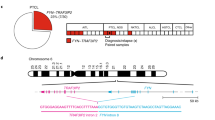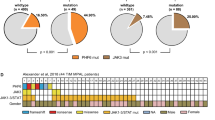Abstract
Despite recent therapeutic improvements, the prognosis for patients suffering from Sézary syndrome (SS), a disseminated form of cutaneous T-cell lymphomas, is still poor. We identified bi- and monoallelic deletions of the tumor necrosis factor-α-induced protein 3 gene (TNFAIP3; A20) in a high proportion of SS patients as well as biallelic A20 deletion in the SS-derived cell line SeAx. Furthermore, we demonstrate that inhibition of A20 activates the NF-κB pathway thereby increasing the proliferation of normal T lymphocytes. On the other hand, the reconstitution of A20 expression slowed down the cell cycle in SeAx cells. Recently A20 inactivation has been reported in various B-cell lymphomas. In this study, we show that A20 is also a putative tumor suppressor in the T-cell malignancy—SS.
This is a preview of subscription content, access via your institution
Access options
Subscribe to this journal
Receive 12 print issues and online access
$259.00 per year
only $21.58 per issue
Buy this article
- Purchase on Springer Link
- Instant access to full article PDF
Prices may be subject to local taxes which are calculated during checkout




Similar content being viewed by others
References
Caprini E, Cristofoletti C, Arcelli D, Fadda P, Citterich MH, Sampogna F et al. Identification of key regions and genes important in the pathogenesis of sezary syndrome by combining genomic and expression microarrays. Cancer Res 2009; 69: 8438–8446.
Van Doorn R, Van Kester MS, Dijkman R, Vermeer MH, Mulder AA, Szuhai K et al. Oncogenomic analysis of mycosis fungoides reveals major differences with Sezary syndrome. Blood 2009; 113: 127–136.
Sors A, Jean-Louis F, Pellet C, Laroche L, Dubertret L, Courtois G et al. Down-regulating constitutive activation of the NF-kappaB canonical pathway overcomes the resistance of cutaneous T-cell lymphoma to apoptosis. Blood 2006; 107: 2354–2363.
Dixit VM, Green S, Sarma V, Holzman LB, Wolf FW, O'Rourke K et al. Tumor necrosis factor-alpha induction of novel gene products in human endothelial cells including a macrophage-specific chemotaxin. J Biol Chem 1990; 265: 2973–2978.
Malynn BA, Ma A . A20 takes on tumors: tumor suppression by an ubiquitin-editing enzyme. J Exp Med 2009; 206: 977–980.
Heyninck K, Denecker G, De Valck D, Fiers W, Beyaert R . Inhibition of tumor necrosis factor-induced necrotic cell death by the zinc finger protein A20. Anticancer Res 1999; 19: 2863–2868.
Lin SC, Chung JY, Lamothe B, Rajashankar K, Lu M, Lo YC et al. Molecular basis for the unique deubiquitinating activity of the NF-kappaB inhibitor A20. J Mol Biol 2008; 376: 526–540.
Schmitz R, Hansmann M-L, Bohle V, Martin-Subero JI, Hartmann S, Mechtersheimer G et al. TNFAIP3 (A20) is a tumor suppressor gene in Hodgkin lymphoma and primary mediastinal B cell lymphoma. J Exp Med 2009; 206: 981–989.
Skaug B, Jiang X, Chen ZJ . The role of ubiquitin in NF-kappaB regulatory pathways. Ann Rev Biochem 2009; 78: 769–796.
Wertz IE, O'Rourke KM, Zhou H, Eby M, Aravind L, Seshagiri S et al. De-ubiquitination and ubiquitin ligase domains of A20 downregulate NF-kappaB signalling. Nature 2004; 430: 694–699.
Chanudet E, Ye H, Ferry J, Bacon CM, Adam P, Müller-Hermelink HK et al. A20 deletion is associated with copy number gain at the TNFA/B/C locus and occurs preferentially in translocation-negative MALT lymphoma of the ocular adnexa and salivary glands. J Pathol 2009; 217: 420–430.
Zhang SQ, Kovalenko A, Cantarella G, Wallach D . Recruitment of the IKK signalosome to the p55 TNF receptor: RIP and A20 bind to NEMO (IKKgamma) upon receptor stimulation. Immunity 2000; 12: 301–311.
De Valck D, Jin DY, Heyninck K, Van de Craen M, Contreras R, Fiers W et al. The zinc finger protein A20 interacts with a novel anti-apoptotic protein which is cleaved by specific caspases. Oncogene 1999; 18: 4182–4190.
Krikos A, Laherty CD, Dixit VM . Transcriptional activation of the tumor necrosis factor alpha-inducible zinc finger protein, A20, is mediated by kappa B elements. J Biol Chem 1992; 267: 17971–17976.
Heyninck K, Beyaert R . A20 inhibits NF-kappaB activation by dual ubiquitin-editing functions. Trends Biochem Sci 2005; 30: 1–4.
Turer EE, Tavares RM, Mortier E, Hitotsumatsu O, Advincula R, Lee B et al. Homeostatic MyD88-dependent signals cause lethal inflammation in the absence of A20. J Exp Med 2008; 205: 451–464.
Willemze R, Jaffe ES, Burg G, Cerroni L, Berti E, Swerdlow SH et al. WHO-EORTC classification for cutaneous lymphomas. Blood 2005; 105: 3768–3785.
Gootenberg JE, Ruscetti FW, Mier JW, Gazdar A, Gallo RC . Human cutaneous T-cell lymphoma and leukemia cell lines produce and respond to T-cell growth factor. J Exp Med 1981; 154: 1403–1418.
Kaltoft K, Bisballe S, Dyrberg T, Boel E, Rasmussen PB, Thestrup-Pedersen K . Establishment of two continuous T-cell strains from a single plaque of a patient with mycosis fungoides. In Vitro Cell Dev Biol 1992; 28A: 161–167.
Kaltoft K, Bisballe S, Rasmussen HF, Thestrup-Pedersen K, Thomsen K, Sterry W . A continuous T-cell line from a patient with Sezary syndrome. Arch Dermatol Res 1987; 279: 293–298.
Novak U, Rinaldi A, Kwee I, Nandula SV, Rancoita PM, Compagno M et al. The NF-{kappa}B negative regulator TNFAIP3 (A20) is inactivated by somatic mutations and genomic deletions in marginal zone lymphomas. Blood 2009; 113: 4918–4921.
Honma K, Tsuzuki S, Nakagawa M, Tagawa H, Nakamura S, Morishima Y et al. TNFAIP3/A20 functions as a novel tumor suppressor gene in several subtypes of non-Hodgkin lymphomas. Blood 2009; 114: 2467–2475.
Duwel M, Welteke V, Oeckinghaus A, Baens M, Kloo B, Ferch U et al. A20 negatively regulates T cell receptor signaling to NF-kappaB by cleaving Malt1 ubiquitin chains. J Immunol 2009; 182: 7718–7728.
Kato M, Sanada M, Kato I, Sato Y, Takita J, Takeuchi K et al. Frequent inactivation of A20 in B-cell lymphomas. Nature 2009; 459: 712–716.
Lee EG, Boone DL, Chai S, Libby SL, Chien M, Lodolce JP et al. Failure to regulate TNF-induced NF-kappaB and cell death responses in A20-deficient mice. Science 2000; 289: 2350–2354.
Stilo R, Varricchio E, Liguoro D, Leonardi A, Vito P . A20 is a negative regulator of BCL10- and CARMA3-mediated activation of NF-kappaB. J Cell Sci 2008; 121: 1165–1171.
Coonaert B, Baens M, Heyninck K, Bekaert T, Haegman M, Staal J et al. T-cell antigen receptor stimulation induces MALT1 paracaspase-mediated cleavage of the NF-kappaB inhibitor A20. Nat Immunol 2008; 9: 263–271.
Acknowledgements
This work was supported by the German José Carreras Leukemia Foundation (C.A.S.), Ministry of Science and Higher Education, Poland (GKP). Funding was provided in part by Framework VII EU (European Union/BMBF-0315207A) grant. The excellent technical assistance of Kathrin Assmus (Klinik für Innere Medizin C, Universität Greifswald) is gratefully acknowledged.
Author information
Authors and Affiliations
Corresponding author
Ethics declarations
Competing interests
The authors declare no conflict of interest.
Additional information
Supplementary Information accompanies the paper on the Leukemia website
Supplementary information
Rights and permissions
About this article
Cite this article
Braun, F., Grabarczyk, P., Möbs, M. et al. Tumor suppressor TNFAIP3 (A20) is frequently deleted in Sézary syndrome. Leukemia 25, 1494–1501 (2011). https://doi.org/10.1038/leu.2011.101
Received:
Revised:
Accepted:
Published:
Issue Date:
DOI: https://doi.org/10.1038/leu.2011.101
Keywords
This article is cited by
-
TNFAIP3 mutation may be associated with favorable overall survival for patients with T-cell lymphoma
Cancer Cell International (2021)
-
STAT3 mutations in natural killer cells are associated with cytopenia in patients with chronic lymphoproliferative disorder of natural killer cells
International Journal of Hematology (2019)
-
A novel method of amplified fluorescent in situ hybridization for detection of chromosomal microdeletions in B cell lymphoma
International Journal of Hematology (2019)
-
Novel phosphorylated TAK1 species with functional impact on NF-κB and β-catenin signaling in human Cutaneous T-cell lymphoma
Leukemia (2018)
-
MiR-125b regulates proliferation and apoptosis of nasopharyngeal carcinoma by targeting A20/NF-κB signaling pathway
Cell Death & Disease (2017)



